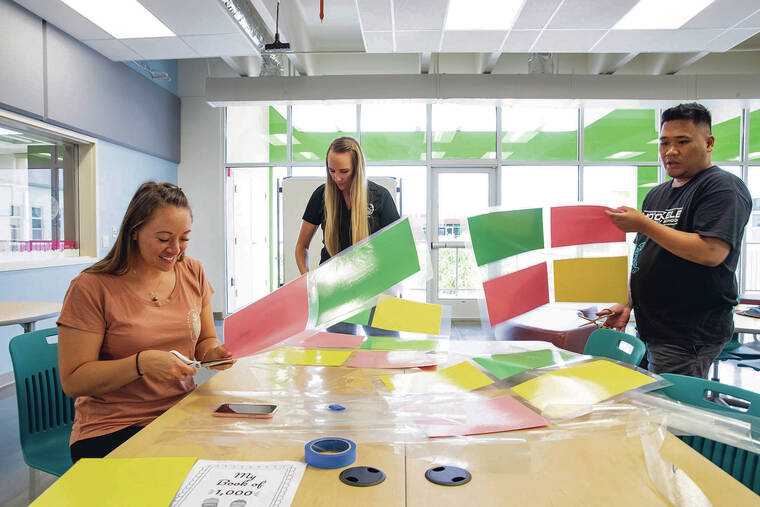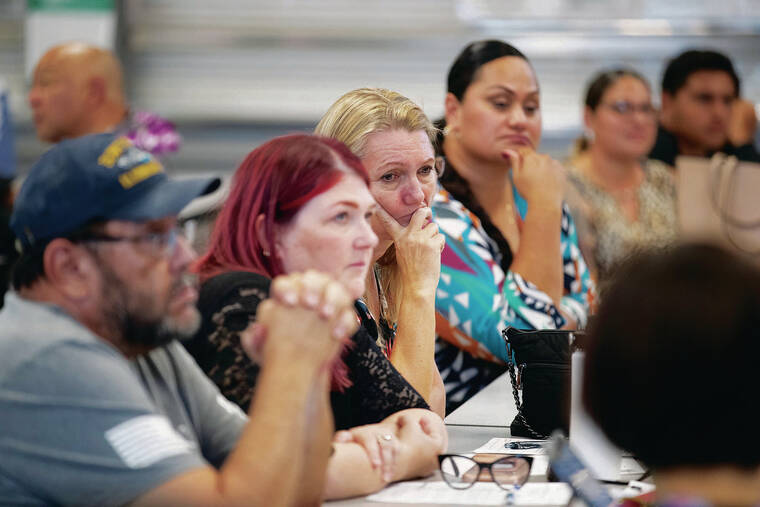On a recent humid Kapolei morning, as Hookele Elementary School teacher Meagan Kautz busily readied her classroom for the start of the new school year, she was not thinking much for the moment about pandemic learning loss, masking rules, mass violence or any of the other heavy issues that have dominated the headlines about schools in the past year.
Kautz instead fairly bounced with excitement as she described her first-day-of-school plans for her third graders, including huddling in a “family circle” to get acquainted and set group rules, and hanging out in her cozy carpeted reading corner — things the pandemic prevented one year ago. “Once the students have that joy in their heart and that sense of belonging, they are excited every day thereafter,” Kautz said. On the first day, “you have that one chance to change the students’ outlook that fast.”
Such optimism now among many educators is in striking contrast with the mood at the start of last school year.
>> RELATED: What to know about masking, other pandemic procedures in Hawaii public schools
In August 2021, Hawaii’s public schools were launching with trepidation as the delta variant of COVID-19 surged. Students arrived bruised emotionally and academically after a previous pandemic school year of mostly distance learning. They and teachers encountered a changed landscape, with desks spaced at least 3 feet apart, social-distancing rules that restricted interactive learning, universal masking, and quarantine and isolation mandates that would later lead to rampant absenteeism and missed lessons.
But this time the cuffs are off as Hawaii’s 257 public schools officially open to their 160,000 students today, although some schools have staggered starts. More than three dozen public charter schools and 100-plus private schools also will open over the next few days and weeks.
Despite high community levels of COVID-19 on most islands, many — but not all — teachers, students and parents say they look forward to starting a fresh new year with more freedom and learning opportunities now that students, desks and cafeteria tables are back to groupings, quarantine and isolation rules are more relaxed, and masks are “strongly recommended” but optional both indoors and outdoors (see accompanying story).
It means more interactive lessons and cooperative study projects, more field trips, more family members allowed in the audience at music and drama recitals. It means keiki can talk facing each other over lunch, hug more and, for those who choose to forgo masks, display their emotions.
“Last year was a roller coaster. This year we’re so much more hopeful — we’re excited to see a return to even more normalcy,” said Sean Tajima, complex-area superintendent for the Campbell-Kapolei schools. “Everyone has a different comfort level about wearing a mask, and we’ll respect what everybody chooses … but masks are going to be optional, so I think it’ll be exciting to see people’s faces on campus again and just have our gatherings and just go back to school as we know it.”
Hookele has brought back carpeted nooks in many classrooms for group interaction, and indoor common areas called learning hubs can once again be used by multiple classes at once, said Principal Bryan Rankie. Hookele’s cafeteria table arrangements that once kept students sitting in rows facing one way are now back in clusters, although each still will be limited to six kids with assigned seats. Some other schools that scheduled student lunches in multiple small waves to keep children distanced are going back to larger lunch groupings again, Tajima said.
Kautz has finally been able to once again haul out some of her students’ favorite furniture for the reading corner: her chartreuse green rocking chair with a friendly-looking frog pillow, matching lime beanbags and plump pillows on the floor, all inviting kids to plop down together. Her classroom tables also are no longer arranged in distanced rows all facing the teacher, but in hubs that allow students to once again learn from each other and bond.
Still, the pandemic’s presence is felt here: A filter hums in the corner to clean the air-conditioned air. “I keep the windows open as much as possible to let in the fresh air,” Kautz said. Hand hygiene stations will still stand at Hookele’s hallway entrances. More than half the school employees during this recent visit, including Kautz, the principal and the complex-area superintendent, were still wearing masks indoors.
Air quality a concern
In fact, not everyone feels the more relaxed ways in the schools are safe, especially since COVID-19 community levels are still high by CDC standards in all the state’s major counties except Kauai. The Hawaii State Teachers Association and some leading health experts are among those who have repeatedly called for the DOE to test and improve air quality of all 12,000 of Hawaii’s public school classrooms and be more transparent about results and progress.
“Given the very high level of disease here in Hawaii now, it should be a no-brainer that we keep the indoor school mask mandate in place unless and until either disease levels are low or there are other mitigation measures (like improved ventilation) in place,” said Burke Burnett, founder of the grassroots group Hawai‘i for a Safe Return to Schools, which has 8,500 members on Facebook. Writing in response to a Honolulu Star-Advertiser request for comment, Burnett accused the state of bowing to a vocal minority who oppose masking. “That’s bad public health policy,” said Burnett, who has a teenage daughter in a Honolulu public school.
Related concerns spilled over at a state Board of Education community meeting on Friday. While the meeting was meant to focus mainly on the issue of improving communication between families and schools, and some of the 80 attendees said they were glad masks had become optional in schools, some others seized the moment to talk in person with state schools Superintendent Keith Hayashi about their concerns over COVID-19 spread.
“When are we going to hear about whether all 12,000 classrooms have adequate ventilation? When are we going to hear if they have adequate filtration?” Mara Hanson, a Makakilo parent, asked Hayashi during a small-group discussion. She said the state’s announcing the end of the indoor mask mandate for DOE schools only about two weeks before school’s start didn’t give parents enough time to make plans or consider alternatives. “It is very unfair,” she said.
Hayashi told the small group he was speaking with that the DOE has been diligent is making significant improvements to air quality and monitoring, including distributing thousands of air purifiers and box fans, and conducting professional air-quality assessments. “Our classes are safe. We are ready to go,” he said.
Violence prevention
Other concerns also pressing on the schools as they launch into a new term include the historic levels of mass violence and school shootings across the U.S. The Hawaii DOE and many independent schools are ramping up violence prevention and preparedness.
Kautz says she feels safe on the Hookele campus. But even the design of the relatively new school built in 2015 to include two layers of fencing around a quad of two-story buildings, and a massive black metal gate at the entrance, are reminders of a rising nationwide concern about school safety.
Then there is the ongoing challenge of helping students still suffering aca- demic and social-emotional problems Opens in a new tab caused by extended virtual learning in the 2020-21 year and the continuing stress of the pandemic. Tajima says the lag in social-emotional development is just as big a problem as academic shortfalls — maybe bigger.
To help kids catch up, Hawaii has been marked for nearly $950 million in federal pandemic aid for new education programs and initiatives. But even before the pandemic, Kautz points out, teachers and schools already had systems in place to track each child’s problem areas and promote progress. Pushing through multiple challenges while keeping a laser focus on student learning is par for a teacher’s job, she adds matter-of-factly. “It’s what we have always done.”




